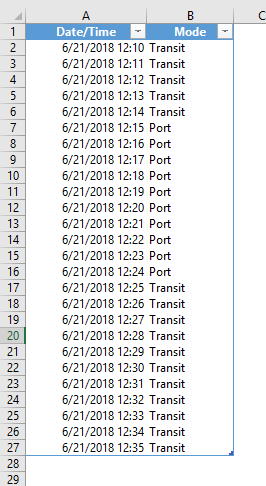First of all, sorry if the title is not explaining the problem properly. It was hard to come up with a proper title as I am fumbling in the dark here.
What I want to solve is this: I have a set of data in a 4-digit number of columns and 2-digit number of rows. In one of the columns information about different modes for offshore vessels are given. This is information the vessel changes when it changes modes. I want to count each time the vessel is changing mode. The data is displayed as follows (example):
Vessel A - 21.06.2018 12:10:55 - Transit - Column 4 - Column 5....
Vessel A - 21.06.2018 12:11:55 - Transit - ……………………………..
Vessel A - 21.06.2018 12:12:55 - Transit - ……………………………..
Vessel A - 21.06.2018 12:13:55 - In Port - ……………………………..
What I want to solve is this: I have a set of data in a 4-digit number of columns and 2-digit number of rows. In one of the columns information about different modes for offshore vessels are given. This is information the vessel changes when it changes modes. I want to count each time the vessel is changing mode. The data is displayed as follows (example):
Vessel A - 21.06.2018 12:10:55 - Transit - Column 4 - Column 5....
Vessel A - 21.06.2018 12:11:55 - Transit - ……………………………..
Vessel A - 21.06.2018 12:12:55 - Transit - ……………………………..
Vessel A - 21.06.2018 12:13:55 - In Port - ……………………………..
Vessel A - 21.06.2018 12:14:55 - In Port - ……………………………..
Vessel A - 21.06.2018 12:15:55 - In Port - ……………………………..
Vessel A - 21.06.2018 12:16:55 - Transit - ……………………………..
Essentially, what i want is to count each time a new instance of a mode appears (each time the vessel changes mode). In this case I want to count transits. Here is shown two seperate transits, as the successive rows are datasets from the same transit.
As I am not very advanced in the use of Excel and PQ, I was hoping some of you might know of a way to solve this. Perhaps there is a formula to count each time information in a column changes or something along those lines.
Vessel A - 21.06.2018 12:16:55 - Transit - ……………………………..
Essentially, what i want is to count each time a new instance of a mode appears (each time the vessel changes mode). In this case I want to count transits. Here is shown two seperate transits, as the successive rows are datasets from the same transit.
As I am not very advanced in the use of Excel and PQ, I was hoping some of you might know of a way to solve this. Perhaps there is a formula to count each time information in a column changes or something along those lines.








